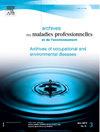Matrices emploi-exposition, utilisation par les professionnels de Santé Travail en France
IF 0.3
4区 医学
Q4 PUBLIC, ENVIRONMENTAL & OCCUPATIONAL HEALTH
Archives Des Maladies Professionnelles Et De L Environnement
Pub Date : 2025-06-30
DOI:10.1016/j.admp.2025.102915
引用次数: 0
Abstract
Introduction
Le suivi et la traçabilité des expositions sont peu réalisés en France, malgré le renforcement par la loi du 02/08/2021 (création de la visite de fin de carrière). L’objectif principal de ce travail de recherche est de quantifier le niveau de connaissance concernant les matrices emploi-exposition (MEE) et leur utilisation pour le suivi des expositions professionnelles dans le domaine de la santé au travail. Les objectifs secondaires sont le recensement des matrices les plus connues et utilisées, la recherche des leviers et des freins d’utilisation des MEE, et des souhaits des professionnels en Santé Travail concernant les MEE. Cet article rapporte un travail de thèse de médecine réalisé en 2023 et présenté en 2024.
Méthodes
Diffusion d’avril 2023 à juillet 2023 (via les réseaux de santé travail et l’Annuaire national de la DREETS des services interentreprise de France) d’un questionnaire LimeSurvey® adressé aux professionnels de Santé Travail participant à l’évaluation des expositions.
Résultats
Sur 1475 réponses, 1358 sont exploitables. Parmi les participants, 58,7 % de l’échantillon connaissent les MEE ; 42,5 % savent où trouver des MEE. Au total, 68,5 % utilisent les MEE et/ou leurs fiches de synthèse, dont 48,5 % utilisant les MEE (dont 19,8 % directement et 29,7 % indirectement), et 54,8 % utilisant les fiches de synthèse des MEE.
Conclusion
Ces résultats mettent en évidence la sous-utilisation des MEE dans la pratique des professionnels de Santé au Travail, tout en soulignant les défis auxquels sont confrontés les professionnels de santé dans leurs utilisations. Pour optimiser l’efficacité de ces outils, des actions doivent être entreprises pour sensibiliser et former les praticiens (notamment l’intérêt des MEE en Santé Travail ; savoir où en trouver ou encore comment utiliser la MEE ou référentiel de fiches de synthèse proposé par le service Santé Travail d’exercice ; expliquer les principaux avantages et limites des MEE), améliorer l’accessibilité et l’ergonomie des MEE ; pour ainsi potentiellement répondre aux besoins spécifiques des différents professionnels de santé au travail.
Introduction
Monitoring and traceability of job exposures are rarely carried out in France, despite the reinforcement with the law of 02/08/2021 (introducing the end-of-career visit). The main objective of this work is to quantify the knowledge concerning Job-Exposure Matrices (JEMs) and their use for monitoring occupational exposures in occupational health practice. The secondary objectives are the census of the most known and used matrixes, the search for pros and cons concerning the use of JEM, and the demands of occupational health professionals concerning JEM. This article reports a thesis work made in 2023 and presented in 2024.
Methods
Dissemination from April 2023 to July 2023 (via occupational health networks and the DREETS national directory of occupational health associations in France) of a LimeSurvey® questionnaire addressed to Occupational Health professionals participating in the assessment of occupational exposures.
Results
Among 1475 total responses, 1358 are usable. Of the participants, 58.7% of the sample know JEM; 42.5% know where to find JEM. Overall, 68.5% use JEM and/or their summary sheets, by combining 48.5% using JEM (including 19.8% directly and 29.7% indirectly), and 54.8% using JEM summary sheets.
Conclusion
These results highlight the underuse of JEM in the practice of Occupational Health, while highlighting the challenges faced by health professionals in their use. To optimize the effectiveness of these tools, actions must be taken to raise awareness and train practitioners (in particular the interest of JEM in Occupational Health; knowing where to find them or how to use the JEM of the Occupational Health service; explaining the main advantages and limitations of JEM), improve the accessibility and usability of JEMs; thus potentially meeting the specific needs of different occupational health professionals.
法国职业卫生专业人员使用的就业暴露矩阵
尽管法国于2021年8月2日颁布了《职业生涯结束参观法》(创建职业生涯结束参观法),但对展览的监测和可追溯性在法国几乎没有实现。这项研究的主要目的是量化关于工作场所接触矩阵及其在职业健康领域的职业接触监测中的应用的知识水平。次要目标是确定最已知和使用的矩阵,寻找使用EMR的杠杆和障碍,以及职业卫生专业人员对EMR的愿望。这篇文章报道了一篇在2023年完成的医学论文,并在2024年发表。方法从2023年4月至2023年7月(通过劳动卫生网络和法国企业间服务部门全国年鉴)分发一份LimeSurvey®问卷,对象是参与评估接触情况的劳动卫生专业人员。在1475条回复中,有1358条是可用的。在参与者中,58.7%的人知道EMR;42.5%的人知道在哪里可以找到MEs。总体而言,68.5%使用MEs和/或其合成表,其中48.5%使用MEs(19.8%直接使用,29.7%间接使用),54.8%使用MEs合成表。结论这些发现突出了职业卫生专业人员在实践中使用电子病历的不足,同时也突出了卫生专业人员在使用电子病历时面临的挑战。为了最大限度地发挥这些工具的效力,必须采取行动提高认识和培训从业人员(包括职业卫生部门的兴趣;了解在哪里可以找到它,或者如何使用EME或职业健康服务处提供的综合数据表;解释EMs的主要优势和局限性),改善EMs的可及性和人体工程学;可能满足工作场所不同卫生专业人员的具体需求。尽管法国于2021年8月2日颁布了一项法律(引入了职业结束访问),但对工作暴露的监测和可追溯性在法国很少实施。这项工作的主要目标是量化关于职业暴露矩阵(JEM)的知识及其在职业健康实践中监测职业暴露的使用。次要目标是最已知和使用的矩阵的普查,搜索与使用YWAM有关的利弊,以及与YWAM有关的职业卫生专业人员的需求。这篇文章报道了2023年完成的论文,并于2017年提交。方法:2023年4月至2023年7月(通过职业卫生网络和法国DREETS国家职业卫生协会目录)向参与职业接触评估的职业卫生专业人员分发LimeSurvey®问卷。结果在1475个响应中,1458个是可用的。在参与者中,58.7%的样本知道YWAM;42.5%的人知道在哪里可以找到YWAM。总的来说,68.5%的人使用YWAM和/或他们的汇总表,48.5%的人使用YWAM(包括19.8%直接和29.7%间接),54.8%的人使用YWAM汇总表。结论这些结果突出了JEM在职业健康实践中未得到充分利用,同时也突出了卫生专业人员在使用JEM时面临的挑战。为了优化这些工具的有效性,必须采取行动提高认识和培训从业人员(特别是YWAM在职业健康方面的利益;知道在哪里可以找到他们,或者如何使用职业卫生服务的YWAM;解释JEM的主要优势和局限性),提高JEM的可访问性和可用性;因此,有可能满足不同职业健康专业人员的具体需求。
本文章由计算机程序翻译,如有差异,请以英文原文为准。
求助全文
约1分钟内获得全文
求助全文
来源期刊

Archives Des Maladies Professionnelles Et De L Environnement
医学-公共卫生、环境卫生与职业卫生
CiteScore
0.40
自引率
50.00%
发文量
185
审稿时长
50 days
期刊介绍:
The Archives of Occupational and Environmental Diseases (Archives des maladies professionnelles et de l''environnement) publish scientific original articles in the form of memoirs, developments and general health reviews. The journal is a reliable source of information, which lets you gain additional knowledge or update your knowledge of basic or original issues.
The section Continuous professional development focuses on a major issue and gives you the tools to optimize your practice. The content is divided in 3 parts: Reading Test, Answer to the Reading Test and Scientific Press Review, which let you share the analysis, by the editorial board, of articles from major English-language journals.
The section Legal Environment discusses an environmental culture. The section Letter to the editor keeps you informed about the press review; the Legislation, with the latest regulations published in the Official Journal; and the agenda of the meetings and the Congress, the questions–answers, etc. The Archives of Occupational and Environmental Diseases include all the scientific communications of the French occupational health societies, of which they are the official journal.
 求助内容:
求助内容: 应助结果提醒方式:
应助结果提醒方式:


